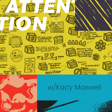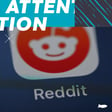Become a Creator today!Start creating today - Share your story with the world!
Start for free
00:00:00
00:00:01

Gong's Process For Shipping Consistent Creative Content w/Sheena Badani
In this episode, Dan Sanchez talks to Sheena Badani who is a Senior Director Of Marketing at Gong.
- Creating a culture of creativity
- Identifying clear owners for ideas
- How they test ideas before fully launching them
Thank You For Listening to the Attention Podcast! Don’t forget to hit Subscribe or Follow us on your favorite podcast player so that you never miss an episode! If you want this podcast delivered to you via email, you can subscribe here: https://www.theirattention.com/p/subscribe/
The Attention Podcast is brought to you by Sweet Fish, the podcast agency for B2B brands.
- Creating a culture of creativity
- Identifying clear owners for ideas
- How they test ideas before fully launching them
Thank You For Listening to the Attention Podcast! Don’t forget to hit Subscribe or Follow us on your favorite podcast player so that you never miss an episode! If you want this podcast delivered to you via email, you can subscribe here: https://www.theirattention.com/p/subscribe/
The Attention Podcast is brought to you by Sweet Fish, the podcast agency for B2B brands.
Transcript
Introduction to Attention Podcast
00:00:04
Speaker
Welcome back to the Attention Podcast, where you learn how to gain and retain the attention of your buyers to build an audience. I'm Dan Sanchez with Sweetfish, and today I interviewed Sheena Badani, who is the Senior Director of Marketing at Gong, about their processes for shipping consistent creative content.
Fostering Creativity in the Workplace
00:00:20
Speaker
In the episode, we cover how they create a culture of creativity, how to identify clear owners for ideas, and how they test ideas before fully launching them. All right, let's get into it.
00:00:36
Speaker
Dana, welcome to the show. Thanks so much, Dan. I'm thrilled to be here today. Fantastic.
00:00:41
Speaker
Well, you and Gong need no introduction with all the work that you do for the podcast.
Creative Content by Gong
00:00:47
Speaker
And with all the work Gong's been doing to put just creative content out there, it seems like all the time there's something new going on. Even last December, I'm pretty sure I used your, maybe it was Thanksgiving, your out of office reply builder, which was fantastic. And I was like, so simple, but so amazing. Like, how did we not think about this?
00:01:06
Speaker
I think after that, for Christmas, we did write our own custom greeting for all the sweet fish that was more like tailored for our company. But I remember seeing things like that. And it just seems like Gong is putting out a consistent stream of awesome ideas to build up your own media audience. So I wanted to ask you and dive into what process do you use for getting these things out all
Aligning Culture with Business Goals
00:01:30
Speaker
the time? How do you come up with new ideas?
00:01:32
Speaker
Yeah, it's a great question. And it's definitely not easy. It's not easy to be creative, to have this constant drumbeat of interesting content and information and to think outside of the box. It really comes down to before we even get into process and how it happens, it's culture. And it is what is instilled in the team, you know, from
00:01:56
Speaker
the executive leadership down and maybe even outside of the marketing organization. I think the audience here is really catered to the marketing org, but as a company, do you think about building in creativity and experimentation
00:02:12
Speaker
and thinking big and different as part of your values, as part of what is recognized, and there are accolades that are provided to that type of work. So that culture is so critical. And if you want to see these unique ideas, like you're talking about this out-of-office builder or something else that may be fun, you do have to think about the business goals and objectives and how it's going to come into play. You do need to think about the process for making these things come to life.
00:02:41
Speaker
and also incentivizing the team to want to do it. But if you're a leader, if you're a manager of a team, I would really think about how are you instilling this into the culture? How are you making room for people to come up with these ideas? And how are you incentivizing them to dedicate any amount of time towards this? And it's not an afterthought. So culture first.
00:03:03
Speaker
I mean, culture is so important, right? Without that, it's the operating system for how the business runs, right? So that every employee doesn't have to ask for permission for every single little thing. They have a decision-making framework called Culture that's not even necessarily thought through, but it's like how they know things are going to go. But I do find that for a lot of companies, this is
00:03:27
Speaker
they do want to be creative. Creativity is something they want it to be part of their culture, but it's aspirational. So I find the devil is in the details when actually making this a part of your culture and making it so employees are actually empowered to do this. But it's not easy. I know I've sat through a lot of like, oh, let's have some brainstorming meetings. And we all end up going out of the meeting being like, was that good? Did we get it done? Or people submit ideas and you're like, ooh,
00:03:55
Speaker
That's a rough one. Yeah, I don't think we're going to do that one. Then that employee never submits an idea again. So there's a lot of details to learn. Just why I'm excited to hear about some of the details and the process of how you guys implement it there.
00:04:09
Speaker
Yes, definitely happy to. I definitely miss the days when we were back in the office,
The Power of In-Person Brainstorming
00:04:13
Speaker
right? The energy that you would get of being in the same room together and being able to riff on other folks' ideas and come up with something else that built upon somebody else's idea, it's really, it is difficult to replicate that virtually. You know, I'll be completely honest about that. So I do miss those moments. One thing that we have been able to do to
00:04:34
Speaker
bring that aspect back to life is anytime we do get together in person, so we have had some off-sites since during this COVID time, and we always have brainstorm sessions as part of that. So depending on what are some of the company priorities, what are our team priorities, what is something that we're trying to solve, we will set aside that dedicated time to bring cross-functional groups together to build upon those ideas and come up with some new concepts.
Ownership and Guidance in Idea Development
00:05:03
Speaker
you talked about like hey who's gonna do something coming out of this meeting like we talked about all these amazing ideas there's no sense of ownership or accountability you know so first you have to make space for those ideas to come you know to life second is identifying clear owners.
00:05:21
Speaker
And different folks will have different roles. The person who had the initial idea may not be the person who's best to take that forward. So I think it's thinking bigger and thinking as a team, because as an idea person, you may feel really bought in or have a strong sense of ownership towards an idea. You may not want to let it go, but it may be actually better to let it flourish under somebody else's guidance. And you can be involved in the right ways going forward.
00:05:47
Speaker
and having a sense of accountability so that, hey, we're actually going to come back and talk about this big idea that we had at our next offsite. How did it go? What were the results? What didn't work? And there does need to be somebody at the helm who is ensuring that we are coming back and talking about these different experiments, that we're talking about these new ideas. Because you're right, it's very easy for something that may not be on a dashboard to fall by the wayside.
00:06:14
Speaker
So there's a number of things there. First, do you have a mechanism to capture ideas or do you wait and expect people to come with their list of ideas to specific meeting times? Or is there a place where they submit it to kind of like act as a holding tank for these ideas? That's a good question. I think it varies a bit by
00:06:32
Speaker
team within the company. And it will evolve as the company grows. So when we were a small company, it was easy to have these ideas and brainstorm sessions in our weekly team meeting and folks would throw out different ideas and somebody could pick it up and take it and run with it. As the team has grown, as the company grows, that's less and less feasible. So making that space that's specific to that brainstorming time becomes a lot more important because it needs that mind share, it needs that time.
00:07:02
Speaker
We use Asana pretty heavily. We use G Suite, like probably a lot of folks who are listening to this. So we do use that to capture some of the ideas and make sure that they're not lost.
Scientific Approach to Creativity
00:07:12
Speaker
But there can be a plethora of ideas in an organization.
00:07:17
Speaker
and it doesn't help to sit on them. So anytime you have one of these sessions or when there is an idea that you want to test out, it's important let's pick one, right? You can get overwhelmed and end up doing nothing because of the volume. So it's important let's pick one thing. Maybe it's one thing for this quarter, maybe it's one thing for this month. It depends on what the test is, it depends on the size of the organization, what you're trying to accomplish.
00:07:41
Speaker
And let's go try. Let's put pen to paper. Let's go execute on this thing and see some results, because only then will you be able to have the energy and the initiative to go do it a second time around. I've certainly gotten to the point where.
00:07:56
Speaker
There's lots of ideas on the table. Maybe we've put them all on the whiteboard. Maybe they're in a sauna list somewhere. How do you go about vetting which idea to try? Because I agree. You have to kind of commit to one or just a few in order to really see them through. Because you've got to keep all the other things you've already committed to doing. You've got to keep those going on top of implementing some new ideas. So how do you vet that?
00:08:18
Speaker
So it's really important to almost bring a scientific approach or put your product manager hat on. You want to think critically and think analytically whenever you're going to do any even creative campaign or creative project. The reason I say that is because I like to come with a hypothesis.
00:08:37
Speaker
And that hypothesis is actually testing some goal that we're trying to achieve. So for example, if you're trying to build a new audience of executive decision makers, you have to have some hypothesis that you want to test in order to get in front of that new audience. So maybe it's we believe executive decision makers are very active podcast listeners. OK, so that's the thing that we want to test. So then you want to break that problem down even further.
00:09:03
Speaker
What are the kinds of podcasts they currently listen to? What are the topics that are relevant for them? So there's some research that's gonna be involved. Maybe you could have one person on the team who specifically goes out and does a little bit of diligence on that front. Then there's gonna be some creative thinking that's gonna come about of what is our approach? What makes our business, our company different? How are we gonna add something of value to this audience?
00:09:26
Speaker
And then comes the creation and the testing and all of that. And it would be easy, again, if you were saying, hey, we're going to test out this podcast idea with executive decision makers, that could be a long road. It's a lot of time, a lot of investment. How could you start small? What is the MVP that you could do to test out that idea? So maybe it's something as small as we're going to do a three-episode series, and we're going to call it a series, and we're going to see how much traction we get.
00:09:54
Speaker
You could say, hey, we're going to actually take a webinar or some existing content that we have and transition that into a podcast and see how that works. But again, how can you take a big hairy thing of we're trying to get in front of decision makers, build a hypothesis, and then figure out tactical things that you're going to do to try to work towards them?
00:10:11
Speaker
I love the MVP idea. My question is, like, how do you get to which ones actually get to MVP, right? Because some ideas will just die with the idea. Yeah, yeah. Do you vote? Do you come up with a ranking algorithm to say, like, oh, let's see, we're going to rank, we're going to judge this idea based on how much it costs, how easy it is, how many people it takes, expected returns? Like, do you have a formula for it? Like, how do you judge your ideas?
00:10:37
Speaker
Yeah, I think it is important to create a framework just like some of those metrics that you were mentioning. Even if you use something simple like a red, yellow, green scorecard to figure out, hey, we have this podcast idea. We also are thinking about doing a newsletter. We're also thinking about doing a live event. Whatever those things are, come up with some basic framework, even a two by two around the possible impact on one axis and the difficulty on another axis. And you'll kind of see where the different ideas land.
00:11:05
Speaker
and you have to be realistic right like what can you do given the resources that you have that could be time that's budget that's you know the rest of the team that's going to be supporting you and go out and pick the one that you'll actually have some chance of seeing some success in if it's a project that you're going to you know hope to see results in a year that's really really tough for a new experiment where you're just trying to prove this new creative idea
00:11:31
Speaker
So I also like to say, put some time box around that. Maybe it's a month, maybe it's a quarter. And try to do something to prove the time and the research that you invested have shown some impact and some results.
Case Study: Print Ad Success
00:11:45
Speaker
So that at the end of that period of time, you can go to your leadership team, go ask for resources.
00:11:52
Speaker
using the data of the results that you've seen to date and then you can always do more and then you can do it better and you can exit kind of that MVP phase and do something a little bit more polished. So are you kind of using that kind of a grid system in order to judge ideas currently? And do you run everything through that or is like the CMO get like carte blanche every once in a while and we're like, we're going to do a Super Bowl commercial, you know?
00:12:15
Speaker
I wish I could say that we all follow the exact same framework, but it's not the case. Things that happen on the product marketing side are going to be very different than brand, than content. It's a little bit of a different framework for each team. The good ideas, they will get bubbled up to the CMO, the ones that we voted on to get that final stamp.
00:12:37
Speaker
OK, so that is part of the process. I'm sure small ideas can be tested without CMO approval, but some of the bigger ideas are probably going to be more timely or more costly. Exactly. Finally, get it submitted to him. Even process-wise, we have a specific experiments budget, which is like part of our CMO's ownership. So he can figure out where he wants to allocate that based on some of these ideas that then get presented to him.
00:13:04
Speaker
So tell me about a couple of cases here, some experiments that succeeded and some experiments that just didn't work out so well.
00:13:12
Speaker
Yeah, let's do that. So one that I could talk about is trying out new channels. So we're a digital first company and we've had really great success on a lot of the typical digital channels. And I was earlier talking about getting in front of an executive audience. So that was one thing that we were keen to do. You know, an idea and a hypothesis that we wanted to test was
00:13:35
Speaker
executives are reading business level print material. So think of Wall Street Journal, think of New York Times, that they're still reading those publications and those brands have some cachet with this audience. And we had never done anything like this before. That had not been a focus for us.
00:13:53
Speaker
And so we decided, hey, let's actually publish a print ad in the Wall Street Journal. And again, this could be a really, really costly initiative. This could be something that could take a tremendous amount of time because it could take buy-in from a lot of different people across the company.
00:14:12
Speaker
And so we wanted to take that MVP approach again. And so what we decided to do is let's just run this in a couple key markets. So we don't have to do a national campaign in Wall Street Journal. Let's just pick a couple markets that are relevant for our business and run and add there. Again, let's try to use what assets we have. Let's try to build, let's create a
00:14:34
Speaker
kind of a tiger team of who's involved in this project. We don't want to get too many people involved because then it'll also take a lot of time. So we had somebody who's like right at copy, somebody who's great at design, somebody who really understands the messaging, pull those folks together and go execute.
00:14:50
Speaker
And, you know, lo and behold, it drove a lot of word of mouth. We were able to amplify on social. We were able to see within Gonk. I don't want to plug the product, but we could see in Gonk who was actually mentioning Wall Street Journal because they may have seen the ad.
00:15:07
Speaker
And so that was definitely an example of something that was new. There was a hypothesis we wanted to test and we went out and did it. And because of the results that we saw, now we know, hey, this is something else that we can consider adding to our playbook when it makes sense. And what was something that you ran that didn't work out so well?
00:15:25
Speaker
Oh, good question. Well, first, I do want to say that whenever you try something that doesn't necessarily work out, don't think about it that you failed, right? There's a few different directions that you could go. So like, one is, was there something that was broken in the experiment that you could fix potentially? So how could you improve it?
00:15:43
Speaker
Second is like could you pivot it in some way so maybe the campaign was right but the audience was off or maybe the audience was right but the messaging was off so is there some way that you could pivot that that initiative and then finally yeah maybe you tried something and it didn't make sense and it doesn't make sense to do that going forward or maybe one day out in the future if something changes of the market or change with your business it would make sense to do that.
00:16:07
Speaker
So one of the big parts of getting all these creative ideas to the forefront is incentivizing employees to submit them,
Incentivizing and Recognizing Ideas
00:16:15
Speaker
right? Because great ideas can come from anywhere and from anyone. And a big part of that is taking all the diverse talents you've spent so much money and time and recruiting to come be a part of your team and getting them to work on these ideas. How do you make it easy for them to do it? And is there any incentivized process for getting the best ideas out?
00:16:35
Speaker
Yeah, it's maybe a cliche, but I think we forget that really great ideas can come from anywhere. And that, again, it comes back to culture. And how are you enabling people to share these ideas? So you could have something simple as a Slack channel where anybody can post new and unique ideas.
00:16:56
Speaker
And it's easier than maybe a live session where some folks who may have a hard time raising their voice, they may not feel comfortable, but on Slack, maybe they're a great writer and they're able to express their ideas in that format. And I think sometimes it's important to also pull in new people. So as a leader, if you're running one of these brainstorms, call on somebody who may be a little bit quiet, pull in somebody who's not as comfortable.
00:17:21
Speaker
And the other thing that I would mention is some folks need more time to think independently before they come into a group session. So pose the question a few days ahead of time, a week ahead of time, before you actually have that team meeting or that brainstorming session. So for the folks who need that time to think creatively or get in that zone or want to go for a walk to build up some of those ideas, they have the time to do that. Not everybody is a spontaneous thinker.
00:17:50
Speaker
One of the things that I have been mulling in my head and I think would be a great idea is to pull in a concept that Google made really popular earlier on was, hey, 10% of any engineer's time can be dedicated to their own passion projects or something that is not tied to their day-to-day.
00:18:10
Speaker
how can we build that in to creative thinking? And how can we incentivize folks to take 10% or X% of their time on projects that may not be tied directly to their day-to-day marketing initiatives, but something else that tie, it does tie to a bigger goal or a pillar that's important to the company. So I think like that could be like a really great way for folks to prioritize this time, for folks to prioritize time to think differently and even try.
00:18:39
Speaker
Of course, you get into some logistical issues on, okay, if they come up with a great idea, where's the budget coming from and all of that. But I think you can work through some of that by pre-planning and having that experiments budget, for example. The other thing is recognition and acknowledgement. And it's really, really important for leaders to give shout outs to folks who have done something big or who took maybe a little bit of a risk and did something differently.
00:19:07
Speaker
share the learnings, share the wins, and share the things that didn't necessarily work out as anticipated on team meetings. We, for example, have had times where we have a specific learnings meeting for our marketing team where we will come and talk about new campaigns, new ideas, and how they performed.
00:19:30
Speaker
and what we may do differently. Because again, if you share that and communicate this across the organization, others can take tidbits out of that. It may be relevant for something else that they're working on too. So giving that recognition, giving those accolades to folks who are thinking big, thinking differently, and then communicating and sharing are both really, really important.
00:19:48
Speaker
I know accomplishing some of these projects is a huge stepping stone for people's careers, right?
Values Driving Innovation
00:19:53
Speaker
So the people that are hungry, the people that are motivated in order to climb the ladder as either as a manager director track or sometimes in a specialty track. Exactly. Submitting your ideas, getting these projects implemented and seeing them through to success is our big part of that.
00:20:10
Speaker
It is. One of our company values is want more. Another one is challenge conventional wisdom. Don't just do what everybody else is doing, but ask questions and do something that's different. Again, it comes back to your company values. Is this built into how you're thinking, how you're rewarding folks? Are there awards you could be giving out to
00:20:37
Speaker
within the marketing organization or as a company to recognize folks that are adhering to those values or recognize folks, you could come up with an award for different ways to recognize big ideas, creative thinking, new initiatives and things of that nature.
00:20:53
Speaker
This is kind of going on a tangent, but the core value you just said, I actually haven't heard it before. I don't think I've looked at Gong's core values, but the one of want more. I'm like, ooh, that hits different. And I think it's just because I find that motivation comes from desire. If you don't desire much, then you won't have much motivation. You are content. Exactly. Which isn't necessarily a bad thing, but you know, achievement and getting the results that we're trying to get usually comes from a high desire of wanting more. Where does that
Ambitious Goal Setting
00:21:23
Speaker
come from?
00:21:23
Speaker
Where did that core value, does that come from the founders?
00:21:27
Speaker
Yeah, I think it really does. If you hear our CEO Amit Bhandoff speak in one town hall that we had, he talked about, if you're setting goals, set them 10 times higher than what you can actually think you can achieve because you can do so much more than what you think you're capable of. If you set it 10 times higher, even if you ultimately achieve some part of that, it will be so much more amazing than if you had set that 1x goal. I think it really does start from
00:21:54
Speaker
from our founders and from the initial folks that were working at the company when it was founded. And they hold true. A lot of, you know, all of our values, they really hold true today. It's part of our everyday vernacular. We give company awards, as I was mentioning, based on all of these values. So people are really recognized for incorporating them. And then we, of course, include them in our hiring to make sure that people are complementing and adding to all of these values in each and every new person that joins the company.
Advice on Risk-Taking and Expression
00:22:25
Speaker
So my last question is, if you could give advice to your past self, maybe in a former job or in a former place, knowing everything you've learned now about how to ship creative content, creative ideas on a consistent basis, what kind of advice would you give your past self? Oh, that's great.
00:22:44
Speaker
I think for me, especially earlier on in my career, I was very much by the books. And what was tried and true and what worked, that was how you performed. That's what you did. And maybe that was part of how I was raised. Maybe it was the industries that I was working in earlier on.
00:23:05
Speaker
And I think part of it was honestly that the companies may not have incorporated some of the things that we were talking about, right? Like really valuing and recognizing that creative thinking and that creative work. So, you know, I would really recommend to my younger self to take bigger risks and express my ideas to the team. I think it can also be intimidating, especially as an entry level professional. You may have a great idea and you think it's a bad idea.
00:23:34
Speaker
or you're just really, really shy or nervous to express that to your leadership or to your manager or to a cross-functional partner. But being in a leadership position now, I value so much the ideas I come from across the team and really no idea is a bad idea because something can be built on top of it, something we actually take and put into play. So those fresh perspectives that thinking differently is valued so much. And so those would be the couple of things that I would tell my younger self. It's fantastic.
Conclusion and Further Resources
00:24:03
Speaker
Sheena, thank you so much for joining me on the Attention Podcast. Where can people go to connect with you online to learn more? Yeah, you can find me on LinkedIn. I also do host a podcast just like you, Dan, which is catered to revenue leaders. And we interview senior leaders who are running sales, marketing, and CS organizations. It's called Reveal, the Revenue Intelligence Podcast. So I look forward to connecting with any of you who choose to tune in. Fantastic. Thanks again for joining me on the show.
00:24:32
Speaker
Thanks so much, Dan. Now let's talk about what caught my attention in this interview. Sheena put down multiple nuggets that we could walk away with, but it works better if you implement them step by step together. So I went back through the interview and collected them all and found that there were seven steps you can take in order to scale your creative output as a company. So let's go through the seven real quick. First,
00:24:56
Speaker
is create a system for collecting ideas. It could be as simple as a Google spreadsheet where everybody just dumps their ideas. It could be an Asana project where it's collected. It could be as simple as the old school writing things on paper and putting it in a box somewhere, though I don't think anybody's doing that these days.
00:25:15
Speaker
there has to be a place to collect the ideas. Number two, give people a heads up before you brainstorm. If you're going to be going through specific ideas and flushing them out or going through ideas or you have a specific problem you'd like to generate some ideas around, some people don't think about good ideas on the fly. You have to give them time to think about it. So give them time, give them a heads up before you brainstorm. Number three, you work through the list together.
00:25:40
Speaker
and then score the items. You go through the list and then you essentially create some kind of algorithm or some kind of matrix in order to score it. It could be really simple or it could be more sophisticated. I know there's a few different things that I've looked at before, like ease of execution, how much does it cost, likelihood of success, impact if it is successful. All those things you can give a little score, one through 10, one through three, one or two, you know, off and on. Like it's up to you how you make it, but do it as a group together.
00:26:10
Speaker
Number four, bonus if you could do it in person. She really emphasized like getting together when taking advantage of the times they were together to do this. Number five, test the vetted list with an MVP. So boil it down. What's the thing that you can do? Like how can you make it small enough that it's so it's a viable test, but it's easy to execute in order to figure out if this thing's going to work.
00:26:33
Speaker
So test it with an MVP. Number six, roll out ideas that test positive or pivot ideas that didn't work out so well. Number seven, praise contributors generously. This plays in big with creating a culture of creativity, which you need to get back to number one, collecting ideas. The more ideas you have, the more likely the best ones are going to be able to filter up through the top. So you need more ideas and the best way to get them is to praise the ones who are actually submitting them and then
00:27:01
Speaker
that are seeing wins across the board. So those are the seven steps. Hopefully this has helped you kind of think through what you might be missing in your company if you're implementing some of these or what you can try and experiment with your own team this week.
















